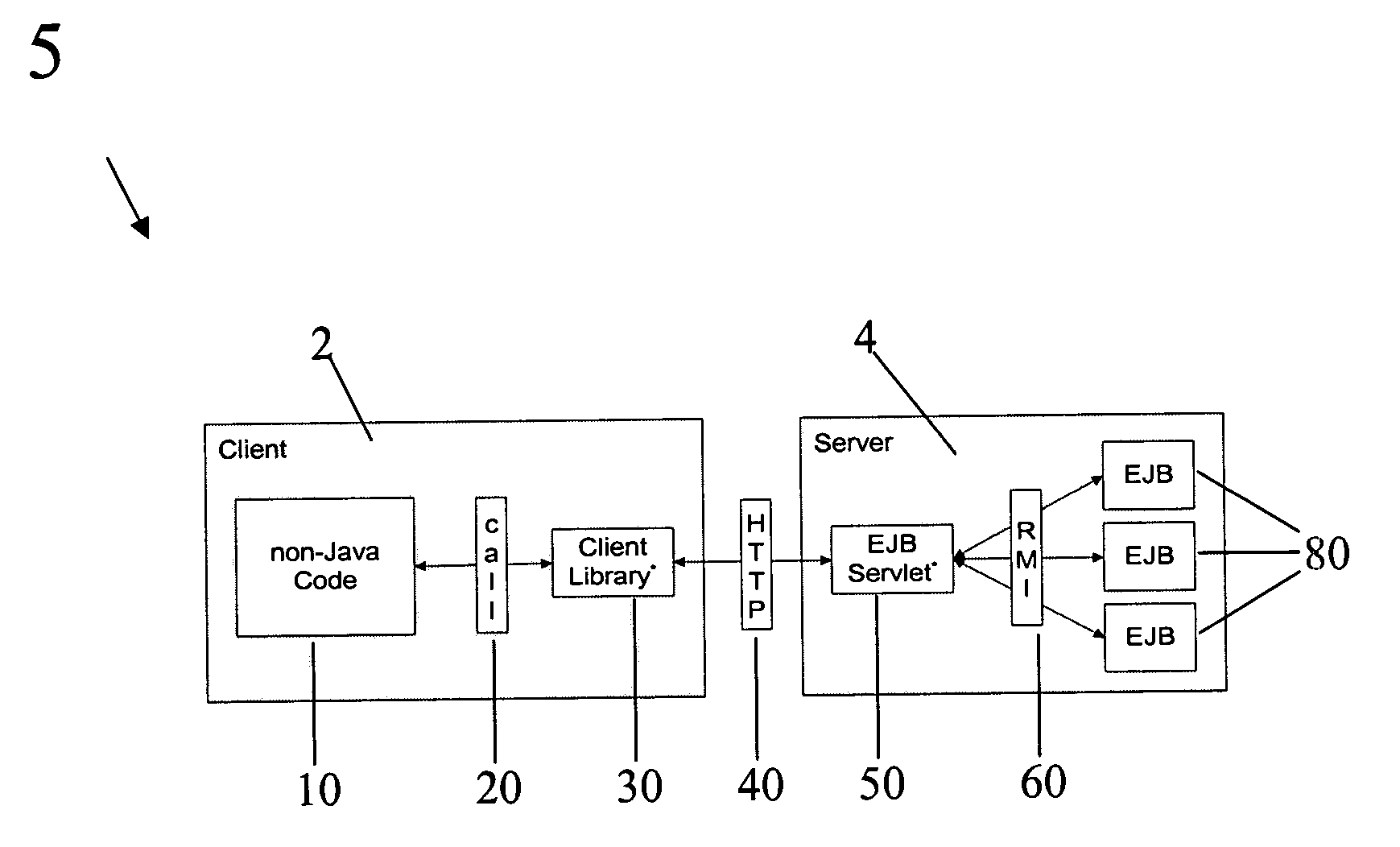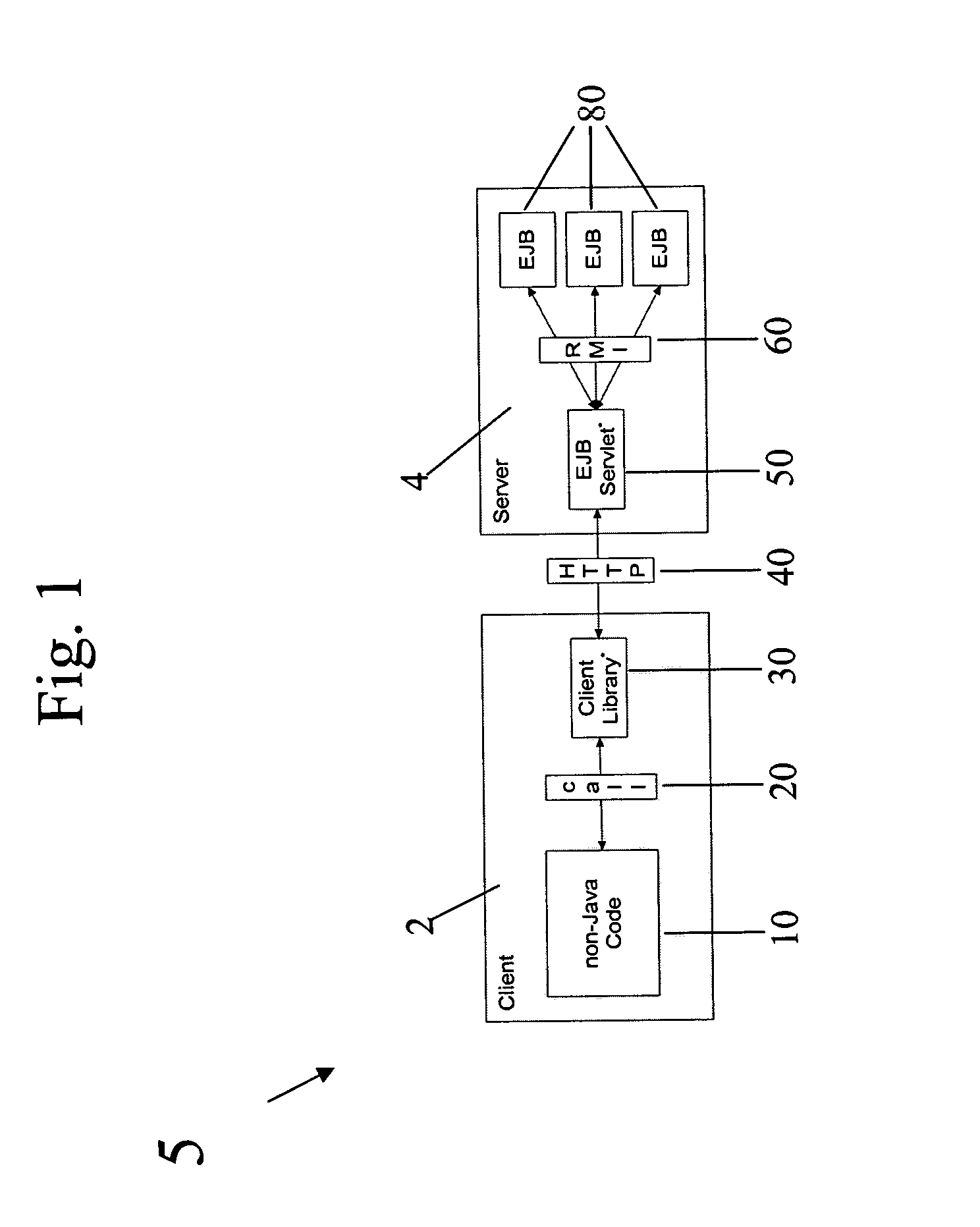Computer method and system for integrating enterprise JavaBeans into non-Java environments
a computer method and system technology, applied in computing, digital computers, instruments, etc., can solve the problems of inverse problem of integrating java components, especially enterprise javabeans, into non-java environments, which has received relatively little attention to date, and is supported in non-java environments
- Summary
- Abstract
- Description
- Claims
- Application Information
AI Technical Summary
Benefits of technology
Problems solved by technology
Method used
Image
Examples
example 1
[0114]The following example demonstrates an application making a call to the webCall function of WebCall 5 that has been described in the present disclosure. The call typically can be made using any non-Java language but for demonstration purposes a pseudo-code is shown. The example shown sets up the call string, allocates the buffers, and makes the call to the EJB method. Note that the ‘int code’ is the return value representing the status code.
/ / Set up the call string
String call[1000]
String newline=CHR(10) / / linefeed character
[0115]call=“package=com.sprint.service.account.component”+newline+“homeInterface=AccountHome”+newline+“jndiName=Account”+newline+“methodSig=findInfo(String,String,String,int,String)”+newline+“methodParams=,John Doe,USA,male,50,555-55-5555”
/ / Allocate buffers for data and format descriptor
int bufSize=60000
String data[bufSize]
String format[bufSize]
/ / Call EJB method
int code=webCall(“IDServer.corp.sprint.com”, 80, “EjbServlet”, call, call.length( ), data, bufSize, ...
example 2
[0118]The following example demonstrates an application making a call to the webCallSession function of WebCall 5 that has been described in the present disclosure. Again, the call typically can be made using any non-Java language but for demonstration purposes a pseudo-code that is similar in form to Visual Basic is shown. The example shown sets up the call string, allocates the buffers, makes the initial call to the EJB method, and sets up a loop to get the results.
′Declare some useful types and variables
Const WebCallBufferSize as Integer=30000
Type WebCallResults
[0119]dataBuf as String*WebCallBufferSize
[0120]dataLen as Integer
[0121]dataPos as Integer
[0122]formatBuf as String*WebCallBufferSize
[0123]formatLen as Integer
[0124]formatPos as Integer
[0125]status as Integer
End Type
Dim results(3) as WebCallResults
Type WebCallValue
[0126]tagType as String
[0127]name as String
[0128]pos as Integer
[0129]size as Integer
[0130]data as String
End Type
′-------------------------------------------------...
example 3
[0202]The following example demonstrates an application making a call to the webCallSetLogging function of WebCall 5 that has been described in the present disclosure. As mentioned previously, the call typically can be made using any non-Java language but for demonstration purposes a pseudo-code is shown. The example shown sets up a file to store logging information on the client library that could be accessed by the non-Java application programmer for debugging purposes.
/ / Direct logging to specified file
int logFileSet=webCallSetLogging((“logs / WebCallclient.log”);
[0203]The following example is included to explain how to deploy the distributed component of the present disclosure on a WebLogic 6.0+.
PUM
 Login to View More
Login to View More Abstract
Description
Claims
Application Information
 Login to View More
Login to View More - R&D
- Intellectual Property
- Life Sciences
- Materials
- Tech Scout
- Unparalleled Data Quality
- Higher Quality Content
- 60% Fewer Hallucinations
Browse by: Latest US Patents, China's latest patents, Technical Efficacy Thesaurus, Application Domain, Technology Topic, Popular Technical Reports.
© 2025 PatSnap. All rights reserved.Legal|Privacy policy|Modern Slavery Act Transparency Statement|Sitemap|About US| Contact US: help@patsnap.com


